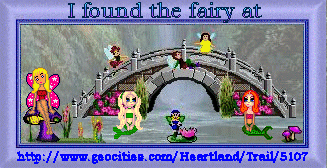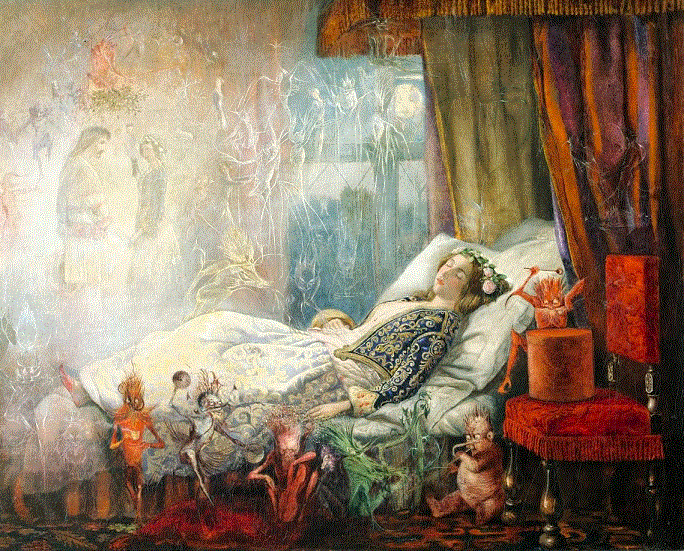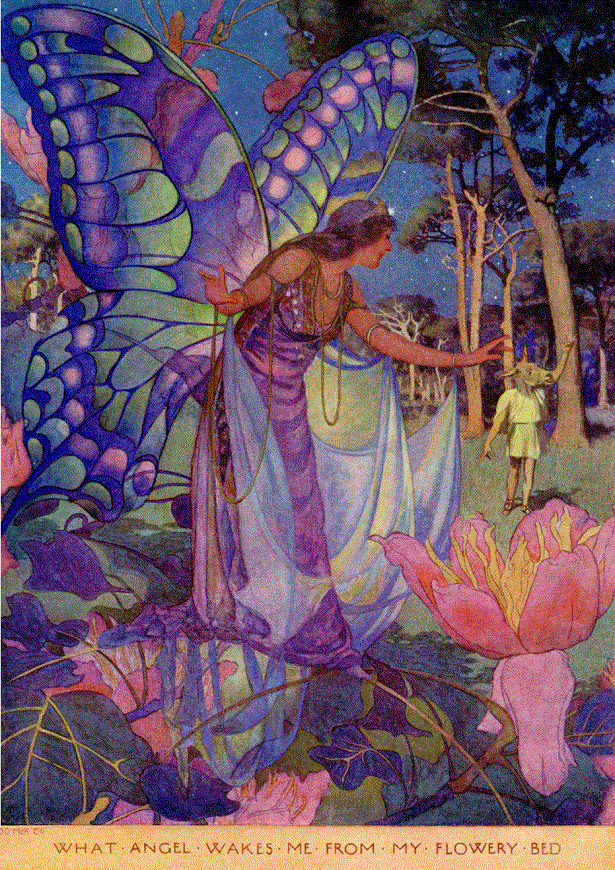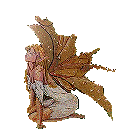The Story
In 1916/17 Frances Griffiths and Elsie Wright, two
young girls living in Cottingley, produced the most
famous fairy pictures in Britain which are still talked
about today.
The first photograph was taken in July 1917 and showed
Frances with the fairies.
Frances and Elsie had been teased about their story of
seeing fairies near Cottingley Beck. Elsie borrowed her
father's quarter plate camera ,which he set to 1/50s at
f/11 for her, and after some rudimentary instruction on
how to operate it, she went off with Frances into the
area where the beck ran among the trees behind the
family home. An hour later they returned triumphant.
When Mr. Arthur Wright (one of the earliest qualified
electrical engineers), and Elsie went into the dark room
that evening to develop the plate, there were the
fairies. Arthur asked what those bits of paper were
doing on the picture?
The second photograph of the gnome resulted in the
girls being banned from borrowing the camera again. The
photographs were put away by Mr. Wright in a drawer as
he considered them to be pranks. (Mrs. Wright was
convinced of their authenticity.)
In 1918 Frances wrote to her friend Johanna Parvin in
South Africa and enclosed a copy of the photograph. On
the back of the photo she had written 'Elsie and I are
friendly with the beck fairies. Funny, I never used to
see them in Africa. It must be too hot for them there.
The letter from Frances ran thus: '. . . all think the
war will be over in a few days, we are going to get our
flags to hang up in our bedroom. I am sending you two
photos, both of me, one is me in a bathing costume in
our back yard, uncle Arthur took that, while the other
is me with some fairies up the beck, Elsie took that
one. Rosebud is as fat as ever and I have made her some
new clothes. How are Teddy and dolly?' In her letter to
Johanna, Frances was more interested in talking about
the war and her dolls and the photo with the fairies was
given but scant and matter of fact reporting. As if
seeing fairies was to her an every day occurrence of
little importance.
Three years later Mrs Wright went to a folklore
lecture in Bradford with a friend. This lecture included
references to fairies and following the lecture in
conversation with her friend mentioned the fairy
pictures. They were overheard by a friend of Edward
Gardner, a leading theosophist, and Edward asked to see
them.
Fred Barlow, a leading authority on psychic
photography, commented to Gardner in June 1920 - 'I am
inclined to think, in the absence of more detailed
particulars, that the photograph showing the four
dancing fairies is not what it is claimed to be....' and
in December 1920 - 'I am returning herewith the three
fairy photographs you very kindly loaned to me, and have
no hesitation in announcing them as the most wonderful
and interesting results I have ever seen.'
Gardner sought a photographer who had the ability to
examine the photographs fully and so it was that Harold
Snelling came to his notice. He was informed that 'What
Snelling doesn't know about faked photographs isn't
worth knowing.' Snelling's considered judgement, in his
letter to Edward Gardner of July 31 1920, was 'These two
negatives are entirely genuine unfaked photographs of
single exposure, open-air work, show movement in all the
fairy figures, and there is no trace whatever of studio
work involving card or paper models, dark backgrounds,
painted figures, etc. In my opinion, they are both
straight untouched pictures.'
Mr. Gardner asked Snelling to make contact positives
and two lantern slides of the photographs. These lantern
slides were shown by him at a lantern lecture at
Mortimer Halls, London. Through this the photographs
came to the notice of Sir Arthur Conan Doyle.
On hearing of Mr. Snelling's opinion, it was proposed,
and agreed, that if the negatives survived a second
expert's judgment, preferably Kodak's, then Edward
Gardner and Conan Doyle should join forces and make the
photographs a leading feature in the Strand article.
Accordingly an appointment was made with Kodak's
manager. They were received by Mr. West, the manager.
His studio chief and two other expert photographers were
also present. The negatives were examined by all at some
length, and the results of the inspection were as
follows, all agreeing.
- The negatives are single exposure.
- The plates show no sign of being faked work, but
that cannot be taken as conclusive evidence of
genuineness.
- Kodak's were not willing to give any certificate
concerning them because photography lent itself to a
multitude of processes, and some clever operator might
have made them artificially.
- The studio chief added that he thought the
photographs might have been made by using the glen
features and the girl as a background; then enlarging
prints from these and painting in the figures; then
taking half-plate and finally quarter-plate snaps,
suitably lighted. All this, he agreed, would be clever
work and take time.
- A remark made by one was that 'after all, as fairies
couldn't be true, the photographs must have been faked
somehow.'
They came from Kodak's without a certificate. It was
decided there and then that one of them would go to
Yorkshire, interview the family in their home
environment.
Edward Gardner then travelled to Cottingley and spoke
to Mrs. Wright and Elsie, who answered his questions
willingly and candidly. He spoke separately to Mr.
Wright later the same day and found him to be of
forthright speech and character and having a cheerful
disposition. Mr Wright told Mr. Gardner that he had been
so convinced at the time that the figures must be made
of paper or something like paper, that while the
children were out he searched their bedroom for some
sign and he also searched the glen and waterfall. But in
neither the house nor the glen did he find anything. Mr.
Wright agreed to the Strand publication as long as
proper names were not used. Sir Arthur had wished to
make some monetary payment for this but Mr. Wright very
firmly declined, saying that if the photographs were
genuine they shouldn't be soiled by being paid for!

In 1920 The Strand magazine published an article
entitled "An Epoch Making Event - Fairies Photographed",
(the publication sold out within days), and so began a
controversy which raged on for nigh on a century.
The articles in The Strand:
- The Absolute Proof. November 1920, Vol. 60, pp. 439
- 445.
- December 1920, Vol. 60, pp. 463 - 468. Doyle's
acceptance and publication of pictures showing young
girls photographed with fairies caused a sensation and
great controversy.
- March 1921, Vol. 61, pp. 199 - 206. More pictures
attempting to prove the genuineness of fairies. -
Fairies Photographed. The Cottingley Fairies.
- February 1923, Vol. 65, p. 105- The Evidence for
Fairies.
In 1921 Conan Doyle arranged for Geoffrey Hodson, a
medium, to come to Cottingley, sit with the girls, in
the hope that even stronger shapes would materialize. In
August 1921 Mr Hodson reported seeing wood elves under
some beech trees as well as dancing fairies in the
field. These incidents are reported in his book 'Fairies
at Work and Play'. He also states in his book 'I am
personally convinced of the bona fides of the
two girls who took these photographs. I spent some weeks
with them and their family, and became assured of the
genuineness of their clairvoyance, of the presence of
fairies, exactly like those photographed, in the glen at
Cottingly(sic), and of the complete honesty of all
parties concerned.'

Sir Arthur Conan Doyle, of Sherlock Holmes fame, was
entirely convinced by the photographs and to demonstrate
his unshakeable belief in the spirit world, he published
The Coming of the Fairies in 1922. It recounted
the story of the photographs, their supposed provenance,
and the implications of their existence.
Frances moved to Scarborough in the 1920's and Elsie
worked at several jobs mainly with an artistic
background.
Elsie eventually emigrated to the USA where she met
her husband Frank Hill. They moved to India and lived
there until 1949. They then settled back in England in
the Midlands with their son.
Frances married a soldier in 1928 - Sydney Way - and
after many postings overseas finally settled in
Ramsgate.
Over the years Elsie stated constantly that, although
the fairies were wonderful, she needed to try to forget
all about them. She said that down the years she got fed
up of talking about them.
Elsie and Frances remained tight-lipped until 17th
February 1983 when Elsie admitted in a letter of
confession that the photographs were a hoax, claiming
that they had drawn the fairies, cut them out and
fastened them to the ground with hatpins. So that was
that!
Or was it? The mystery still lives on with many people
still believing that the Cottingley fairies existed.
Frances maintained in her last television appearance in
1986 that 'there were fairies at
Cottingley'.
Elsie died in April 1988 and Frances died in July
1986. They gave us a story that has stood the test of
time and has done no harm to anyone. It may be that the
real hoax was 'the confession', made in the hope that
they could spare their families from the press, and that
somewhere in the spirit world they are both having the
'last' laugh.

Even today these photographs continue to mystify and
fascinate the world. All this with the first photograph
that a young girl took.
In 1990 Joe Cooper's book "The Case of the Cottingley
Fairies" was published. He investigated the whole story
and Colin Wilson in the foreword to the book states that
it is "as near as we shall ever come to the complex
truth behind the case of the Cottingley Fairies".
A Warner Bros Film "Fairy Tale - A True Story" held
its British premiere in Bradford in 1998 which tells the
story of Frances and Elsie.
Frances was born 1907 and following the fairy affair
returned to Scarborough. She always maintained that at
least one of the photos was not fake. She died in 1986.
Elsie was born 1900. Due to hounding by the English
press following the fairy story, she went to America,
married and eventually returned to Britain. She died in
1988 at the age of 88.
Sir Arthur Conan Doyle (born 1859) died on 7th July
1930
Edward Gardner died in 1970 at the age of 100.
Geoffey Hodson born 12 March 1886 died at age 96 on 23
January 1983

In the 1980's a former wrestler (Ronnie Bennett) and
then forester in Cottingley Woods, admitted to having
seen fairies in the woods. He claimed he saw the
elf-like figures while working in the Cottingley Estate
Woods. "When they showed themselves about nine
years ago there was a slight drizzle around. I saw
three fairies in the woods and I have never seen them
since. They were just about ten inches tall and just
stared at me. There is no way the Cottingley Fairies
is a hoax."
Geoffrey Crawley tells his personal story of the
longest running photography hoax carried out by two
Yorkshire schoolgirls in the British Journal of
Photography.5/1/2000. Unfortunately this article is no
longer available on line. A transcript is available for
perusal at the Cottingley Town Hall Heritage Day
Geoffrey Crawley was born on 10th December 1926 and
died on 29th October 2010. An obituary to Mr Crawley
appeared in the Daily Telegraph on 8th November 2010
Joe Cooper, who researched the fairy story and wrote
the book "The Case of the Cottingley Fairies" which was
published in 1990, died on 16th August 2011 at the age
of 87

 ~The Cottingley
Fairies Were Real~
~The Cottingley
Fairies Were Real~























